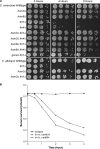Fungal homoserine kinase (thr1Delta) mutants are attenuated in virulence and die rapidly upon threonine starvation and serum incubation
- PMID: 20305003
- PMCID: PMC2863962
- DOI: 10.1128/EC.00045-10
Fungal homoserine kinase (thr1Delta) mutants are attenuated in virulence and die rapidly upon threonine starvation and serum incubation
Abstract
The fungally conserved subset of amino acid biosynthetic enzymes not present in humans offer exciting potential as an unexploited class of antifungal drug targets. Since threonine biosynthesis is essential in Cryptococcus neoformans, we further explored the potential of threonine biosynthetic enzymes as antifungal drug targets by determining the survival in mice of Saccharomyces cerevisiae homoserine kinase (thr1Delta) and threonine synthase (thr4Delta) mutants. In striking contrast to aspartate kinase (hom3Delta) mutants, S. cerevisiae thr1Delta and thr4Delta mutants were severely depleted after only 4 h in vivo. Similarly, Candida albicans thr1Delta mutants, but not hom3Delta mutants, were significantly attenuated in virulence. Consistent with the in vivo phenotypes, S. cerevisiae thr1Delta and thr4Delta mutants as well as C. albicans thr1Delta mutants were extremely serum sensitive. In both species, serum sensitivity was suppressed by the addition of threonine, a feedback inhibitor of Hom3p. Because mutation of the HOM3 and HOM6 genes, required for the production of the toxic pathway intermediate homoserine, also suppressed serum sensitivity, we hypothesize that serum sensitivity is a consequence of homoserine accumulation. Serum survival is critical for dissemination, an important virulence determinant: thus, together with the essential nature of C. neoformans threonine synthesis, the cross-species serum sensitivity of thr1Delta mutants makes the fungus-specific Thr1p, and likely Thr4p, ideal antifungal drug targets.
Figures





Similar articles
-
Homoserine toxicity in Saccharomyces cerevisiae and Candida albicans homoserine kinase (thr1Delta) mutants.Eukaryot Cell. 2010 May;9(5):717-28. doi: 10.1128/EC.00044-10. Epub 2010 Mar 19. Eukaryot Cell. 2010. PMID: 20305002 Free PMC article.
-
Cytocidal amino acid starvation of Saccharomyces cerevisiae and Candida albicans acetolactate synthase (ilv2{Delta}) mutants is influenced by the carbon source and rapamycin.Microbiology (Reading). 2010 Mar;156(Pt 3):929-939. doi: 10.1099/mic.0.034348-0. Epub 2009 Dec 17. Microbiology (Reading). 2010. PMID: 20019084 Free PMC article.
-
Threonine biosynthetic genes are essential in Cryptococcus neoformans.Microbiology (Reading). 2008 Sep;154(Pt 9):2767-2775. doi: 10.1099/mic.0.2008/019729-0. Microbiology (Reading). 2008. PMID: 18757810 Free PMC article.
-
Stress-Activated Protein Kinases in Human Fungal Pathogens.Front Cell Infect Microbiol. 2019 Jul 17;9:261. doi: 10.3389/fcimb.2019.00261. eCollection 2019. Front Cell Infect Microbiol. 2019. PMID: 31380304 Free PMC article. Review.
-
Mitochondria and fungal pathogenesis: drug tolerance, virulence, and potential for antifungal therapy.Eukaryot Cell. 2011 Nov;10(11):1376-83. doi: 10.1128/EC.05184-11. Epub 2011 Sep 16. Eukaryot Cell. 2011. PMID: 21926328 Free PMC article. Review.
Cited by
-
The Role of Amino Acid Permeases and Tryptophan Biosynthesis in Cryptococcus neoformans Survival.PLoS One. 2015 Jul 10;10(7):e0132369. doi: 10.1371/journal.pone.0132369. eCollection 2015. PLoS One. 2015. PMID: 26162077 Free PMC article.
-
Molecular targets for antifungals in amino acid and protein biosynthetic pathways.Amino Acids. 2021 Jul;53(7):961-991. doi: 10.1007/s00726-021-03007-6. Epub 2021 Jun 3. Amino Acids. 2021. PMID: 34081205 Free PMC article. Review.
-
THR1 mediates GCN4 and CDC4 to link morphogenesis with nutrient sensing and the stress response in Candida albicans.Int J Mol Med. 2018 Dec;42(6):3193-3208. doi: 10.3892/ijmm.2018.3930. Epub 2018 Oct 12. Int J Mol Med. 2018. PMID: 30320368 Free PMC article.
-
Nutritional Requirements and Their Importance for Virulence of Pathogenic Cryptococcus Species.Microorganisms. 2017 Sep 30;5(4):65. doi: 10.3390/microorganisms5040065. Microorganisms. 2017. PMID: 28974017 Free PMC article. Review.
-
The regulation of the sulfur amino acid biosynthetic pathway in Cryptococcus neoformans: the relationship of Cys3, Calcineurin, and Gpp2 phosphatases.Sci Rep. 2019 Aug 15;9(1):11923. doi: 10.1038/s41598-019-48433-5. Sci Rep. 2019. PMID: 31417135 Free PMC article.
References
Publication types
MeSH terms
Substances
Grants and funding
LinkOut - more resources
Full Text Sources
Molecular Biology Databases

